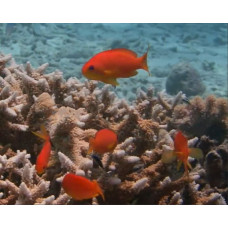Latin name
Pseudanthias squamipinnis
Other name
Orange basslet, lyretail coralfish, onestripe goldie, lyretail anthias, lyretail fairy basslet, orange fairy basslet, orange seaperch, scalefin basslet, scalefin Fairy basslet and scalefin anthias.
Identification
There is a pronounced dimorphism in this species.
Features of fish fins
Dorsal spines (total): 10; Dorsal soft rays (total): 15 - 17; Anal spines: 3; Anal soft rays: 6 - 7.
Males have an elongated third ray of the dorsal fin and the edges of the tail, unlike females.
Fish colouring
Females are orange-gold with a purple stripe under the eye, while males are fuchsia with an elongated third dorsal ray, a red spot on the pectoral fin.
Distribution
Widespread in the western Indian Ocean, including the Red Sea, and in the Pacific Ocean as far east as Japan and south-east Australia. It is absent from the Persian Gulf and Oman.
Habitat
Tropical marine species. This fish lives around coral ledges in clear lagoons, on small reefs and steep slopes. The depth range is 0 to 55 m, usually 5 to 35 m.
Size
Females of this species are up to 7 centimetres (2.75 inches) long and males up to 15 centimetres (5.9 inches) long.
Behavior
Sea goldies are often found in large schools over reefs in the company of Chromis dimidiata.
Food and feeding habits
It feeds mainly on zooplankton.
Reproduction
Like other Anthias, it is an original hermaphrodite; the male maintains a harem of five to ten females, but when a male dies or leaves, the largest and most dominant female undergoes hormonal and physical changes to become the new male of the harem. This change can take anywhere from a few weeks to a few months. Spawning takes place at sunset between December and February in the Red Sea.
Fishing
Sea goldie have little commercial importance in the fishery.
Relationship with a person
Harmless. This species can be found in the aquarium trade.
| Classification | |
| Phylum | Chordata |
| Class | Actinopterygii |
| Squad | Perciformes |
| Family | Serranidae |
| Genus | Pseudanthias |
| Species | P. squamipinnis |
| Features | |
| Conservation status | Least Concern |
| Habitat | Pelagic |
| Life span, years | No information |
| Maximum body weight, kg | No information |
| Maximum length, cm | 15 |
| Sailing speed, m/s | No information |
| Threat to people | Not edible |
| Way of eating | Planktonophage |
Sea goldie
Tags: sea goldie


